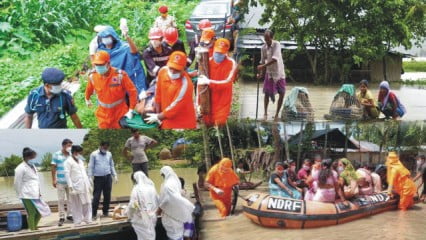

The vast networks of mighty rivers – the Brahmaputra and Barak – in Assam make it prone to flood and erosion which pose major a risk to the health of denizens of the State, increase disease fighting burden on the State – a hinder to the overall development here. To quote Rashtriya Barh Ayog (RBA), the flood prone area of the State is 31.05 lakh hectares, accounting for 39.58% of the total.

In the present scenario four waves of floods from the month of May to July have wreaked havoc in the State resulting in heavy loss human and animal life, property, crop and agricultural land besides other infrastructure. The toll is increasing by the day.
As per Assam State Disaster Management Authority (ASDMA), till now, more than 100 people have been killed due to inundation, many others in landslides, and nearly 9.26 lakh people are displaced in 26 out of 33 districts of Assam. Displacement of significant number of people and contamination of drinking water, unsafe sanitation and hygiene can add great risk of infection and disease outbreak during and after floods.
It should not be forgotten how the outbreak of Japanese Encephalitis in 2019 had worsened the flood situation. The deluge in June 2017 had resulted in the emergence of Enteric fever and Typhoid cases in the border district of Dhubri on the banks of the Brahmaputra. During 2014 swamp spells, three-fold increase in Cholera cases were reported from Lakhimpur district. During 2004 overflows, entire health department of the state was put on maximum alert after thousands people were reported to suffer from the water-borne diseases.

All the past incidences suggest that looming dangers to health issues in the flood affected areas form a bigger challenge to people and authorities.
In many villages of Dibrugarh district people are struggling for drinking water because even the tube-wells are submerged. In many affected areas there was no outlet for the flood water to drain leaving people with no other option but to use the same for their daily use including direct consumption. In such a situation, the occurrence of Diarrhea, Dysentery, fever and skin disease caused by bacterial and fungal infection are on the rise among the habitants.
The stagnant flood water is favourable place of breeding for mosquitoes. Such a situation increases the risk of vector-borne diseases. Till now flood affected areas have reported 23 deaths due to vector diseases of which 21 deaths are due to Japanese Encephalitis (JE) while two people died of malaria. Even the human excreta and other animal waste can be contaminated with eggs and larva and can pollute water bodies, increasing the risk of Helminth parasites and worms causing several disorders. On the other hand, many pathogens requiring multiple intermediate hosts may get easy access through water medium to complete their lifecycles and multiply their number manifold.

In the meanwhile, use of microbes contaminated water for drinking, cooking, bathing, washing clothes and other household work increase the risk of water-borne disease. The pathogenic microorganism and their toxic exudates can cause already discussed conditions such as Cholera, Diarrhea and Typhoid besides Giardiasis and Scabies. Due to weak immunity and poor hygiene children below the age 10 are more likely to be affected with such pathogen.
A report released jointly by ICMR, PHFI, IHME in 2017 “India: Health of the Nation’s State” says use of unsafe Water, Sanitation and Hygiene (WaSH) contribute to highest disease burden in Assam. Against the current background the reason behind the use of unsafe water and sanitation could be well-understood. According to WHO, poor sanitation and hygiene reduce human well-being, social and economic development due to impacts of anxiety, risk of sexual assault and lost educational opportunities. These are also a major factor in several neglected tropical diseases, including intestinal worms Schistosomiasis.
Whereas every year lakhs go homeless or keep shifting from place to place due to perennial floods in the State, the question arises, how people could practice safe sanitation? Can homeless people and illegal migrants be benefited under the various cleanliness schemes of Government such as Swachh Bharat Abhiyan? Is the health of poor and deprived not compromised every year due to floods? How the disease burden due to communicable disease and WaSH be minimized in the state?
THIS TIME ITS DIFFERENT
In time of crisis, when the country is already battling with the COVID-19 pandemic another infectious disease outbreak can prove to be deadly for the population. Till now more than 33,500 positive cases and 86 Covid-19 deaths have been reported from Assam. Whereas, over 3000 villages are marooned, norms of social-distancing are apparently on discount inside the relief camps.

With more than 50,000 people sheltered in 517 Government relief camps the risk of COVID-19 transmission increases among the inhabitants. Many are afraid to avail benefits of the relief camps due to ongoing pandemic.
Adding to the fear of people in inundated areas, flood water has spread discarded medical waste from hospital and COVID-19 care centers.
Coping up with the outbreak of Coronavirus was already a big shock for the residents of Assam, and now the striking JE and malaria spread amid lockdown pose a bigger test for the people and the authorities.

Disclaimer : PunjabTodayTV.com and other platforms of the Punjab Today group strive to include views and opinions from across the entire spectrum, but by no means do we agree with everything we publish. Our efforts and editorial choices consistently underscore our authors’ right to the freedom of speech. However, it should be clear to all readers that individual authors are responsible for the information, ideas or opinions in their articles, and very often, these do not reflect the views of PunjabTodayTV.com or other platforms of the group. Punjab Today does not assume any responsibility or liability for the views of authors whose work appears here.
Punjab Today believes in serious, engaging, narrative journalism at a time when mainstream media houses seem to have given up on long-form writing and news television has blurred or altogether erased the lines between news and slapstick entertainment. We at Punjab Today believe that readers such as yourself appreciate cerebral journalism, and would like you to hold us against the best international industry standards. Brickbats are welcome even more than bouquets, though an occasional pat on the back is always encouraging. Good journalism can be a lifeline in these uncertain times worldwide. You can support us in myriad ways. To begin with, by spreading word about us and forwarding this reportage. Stay engaged.
— Team PT


Copyright © Punjab Today TV : All right Reserve 2016 - 2024 |